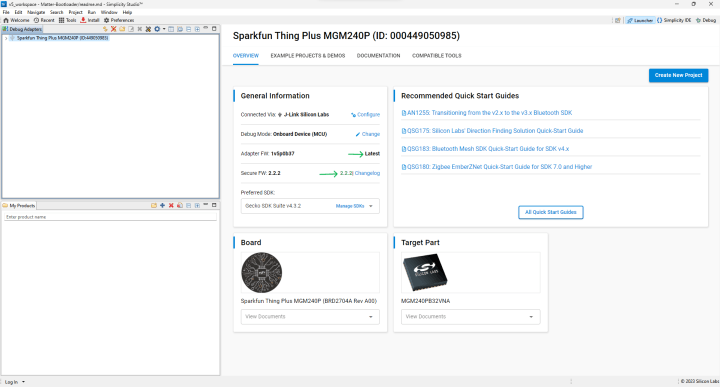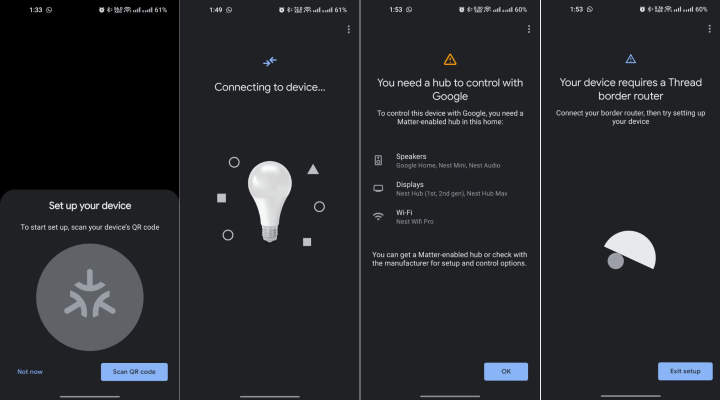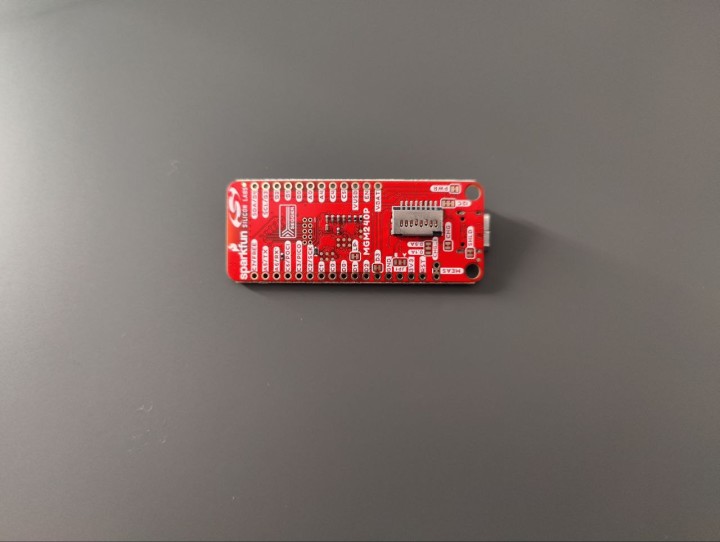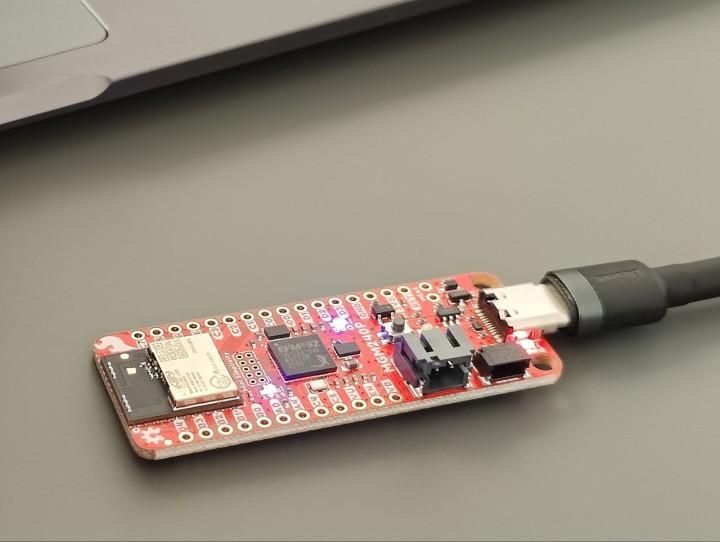SparkFun Thing Plus Matter (MGM240P): A Versatile Matter-Based IoT Development Board (Review)
January 03, 2024
on
on

The SparkFun Thing Plus Matter (MGM240P) is a versatile and feature-rich development board designed for creating Matter-based IoT devices. Matter, formerly known as Project CHIP (Connected Home over IP), is a protocol developed to enable interoperability among smart home and IoT devices, making this board an exciting addition to the IoT development landscape.

Following are the highlights of SparkFun Thing Plus Matter MGM240P:

Flashing the code onto this board is simple, you first need to install Simplicity Studio, plug in your board and the board gets automatically detected. Make sure you upgrade the firmware of your board before using it, as it is always good to keep the board up to date to avoid any bugs and problems which were unfixed in the last firmware.

After updating the firmware, you can simply click “create new project”, and then you have ton of examples suitable for most of the applications for this board. I selected the Example Matter Light Over Thead, built the firmware, and uploaded it to the board.

Setting up the Google Home Dev account, It's required for this. When you upload the code onto the board of your board, your phone automatically detects this device as a matter device and asks for pairing it. I was able to follow the instructions available on the Sparkfun page, but unfortunately, you need to have a Google Hub to control Matter devices with Google. As demonstrated by the figure below, it says, “your devices require a Thread border router”.

But anyway, I didn’t have any concerns along the way and if I had a hub, I am very confident to say that it was going to work.

By default, the charge current is configured at 500 mA. However, there's a three-way jumper labelled CHG, allowing users to switch between 500mA charge current, 100 mA charge current, or disabling the charge IC entirely when it's not needed. In my testing the default charging circuit was working as intended without any issues. This features also allows you slim down your project as now you don’t need to include a charging module in your project.
This debugger offers powerful low-level debugging capabilities when paired with Simplicity Studio's debugging tool. You can perform a wide range of standard debugging tasks, including debugger output, setting code breakpoints, and even delving into assembly code for more detailed analysis.
In summary, the SparkFun Thing Plus Matter (MGM240P) is a good IoT development board tailored for Matter-based IoT solutions. Its compatibility with multiple wireless protocols, Qwiic connectors, battery charging feature and extensive resources from SparkFun and Silicon Labs empowers developers to tackle diverse IoT challenges. Whether you're initiating a new IoT project or elevating an existing one, this board serves as an excellent foundation for your IoT development journey.
Compact and Feature-Packed Design
The SparkFun Thing Plus Matter board features a compact design, 5.84 x 22.9 cm compatible with the Thing Plus form factor (Feather-compatible); with two mounting holes. You can develop software for the MGM240P using the Simplicity Studio debugging tool, which is compatible with Windows, Mac OSX, and Ubuntu. The hookup guide provides detailed hardware information and a step-by-step guide to help you start with the Simplicity Studio IDE.
Following are the highlights of SparkFun Thing Plus Matter MGM240P:
- MGM240P wireless module
- SoC – Silicon Labs EFR32MG24 microcontroller
- Memory/Storage – 1536 kB Flash Memory, 256 kB RAM
- Wireless – 802.15.4 wireless protocols (Zigbee and Open Thread) and Bluetooth Low Energy 5.3; Matter-ready
- Storage – MicroSD card socket
- Two rows of header with 21x GPIO
- 4-pin JST Qwiic connector
- EFM32GG12B410F1024GL120-A microcontroller used as J-Link programmer and debugging IC.
- Unpopulated Mini Simplicity connector to connect an external debugger.
- 2-Pin JST connector for a single LiPo battery (not included) with MC73831 LiPo charger and MAX17048 LiPo fuel gauge
- Power consumption – 15 µA when MGM240P is in Low Power mode.
Matter Protocol Support
The board is designed with Matter protocol support in mind, which is a significant advantage for those looking to create smart home or IoT devices that seamlessly communicate with other Matter-compatible devices. The protocol's ability to unify different IoT ecosystems is a game-changer for IoT development. Subscribe
Tag alert: Subscribe to the tag Matter and you will receive an e-mail as soon as a new item about it is published on our website! Wireless Connectivity and Testing
This board is equipped with an MGM12P module, which is based on the EFR32MG12 family from Silicon Labs. This module provides support for multiple wireless protocols, including Bluetooth Low Energy (BLE) and IEEE 802.15.4 (the foundation of Thread and Matter). There are numerous examples for this board available on the Sparkfun’s Simplicity Studio, in my testing I checked some of these examples, which also includes the Matter Light Over Thread example, which basically develops a Matter lighting app, getting the app running.
Flashing the code onto this board is simple, you first need to install Simplicity Studio, plug in your board and the board gets automatically detected. Make sure you upgrade the firmware of your board before using it, as it is always good to keep the board up to date to avoid any bugs and problems which were unfixed in the last firmware.

After updating the firmware, you can simply click “create new project”, and then you have ton of examples suitable for most of the applications for this board. I selected the Example Matter Light Over Thead, built the firmware, and uploaded it to the board.

Setting up the Google Home Dev account, It's required for this. When you upload the code onto the board of your board, your phone automatically detects this device as a matter device and asks for pairing it. I was able to follow the instructions available on the Sparkfun page, but unfortunately, you need to have a Google Hub to control Matter devices with Google. As demonstrated by the figure below, it says, “your devices require a Thread border router”.

But anyway, I didn’t have any concerns along the way and if I had a hub, I am very confident to say that it was going to work.
Subscribe
Tag alert: Subscribe to the tag IoT & Sensors and you will receive an e-mail as soon as a new item about it is published on our website! Flexible Power Options
The board offers flexible power options, allowing you to power it via USB, a Li-Po battery, or an external power supply, also it has PTH pins connected to the 3.3 V, V_USB, and V_BATT nets. The board is designed with a 2-pin JST connector, providing a connection point for a single-cell LiPo battery, making it suitable for battery-powered applications. To ensure stable operation, the input voltage is regulated by a 3.3 V voltage regulator. Additionally, the board incorporates two key components: the MCP73831 Single-Cell LiPo Charge IC, which handles recharging the connected battery when plugged in via USB-C, and the MAX17048 Single-Cell fuel gauge, which continuously monitors the battery's charge level. In my testing, this features works as intended, it's a good feature to have on this board as most of the IoT devices should be wireless to be more mobile.
By default, the charge current is configured at 500 mA. However, there's a three-way jumper labelled CHG, allowing users to switch between 500mA charge current, 100 mA charge current, or disabling the charge IC entirely when it's not needed. In my testing the default charging circuit was working as intended without any issues. This features also allows you slim down your project as now you don’t need to include a charging module in your project.
Expansion Possibilities with Qwiic Connectors
One of the standout features of this board is its compatibility with Qwiic connectors. Qwiic is SparkFun's plug-and-play system for connecting various sensors and peripherals. It simplifies the hardware setup process, making it easy to add additional components to your IoT projects.
Development Tools and Resources
For developers, the board is well-supported by the Simplicity Studio IDE and a wealth of documentation and example projects from Silicon Labs. Whether you're a beginner or an experienced developer, these resources can help you get started and guide you through the development process.Debugger
This board is equipped with the EFM32GG12B410F1024GL120-A microcontroller, serving as a J-Link programmer and debugger. It comes with a Mini Simplicity Connector for those who want to use an external debugger. By default, the board has the debugger set in standard mode, with the debugger WAKE pin connected to V_USB via the LP jumper. However, users have the option to disconnect this jumper to switch the debugger into Low Power mode.This debugger offers powerful low-level debugging capabilities when paired with Simplicity Studio's debugging tool. You can perform a wide range of standard debugging tasks, including debugger output, setting code breakpoints, and even delving into assembly code for more detailed analysis.
Subscribe
Tag alert: Subscribe to the tag IoT and you will receive an e-mail as soon as a new item about it is published on our website! Interoperability
One of the primary goals of the Matter protocol is to provide interoperability between various IoT devices, regardless of their manufacturers. With the SparkFun Thing Plus Matter board, you're in an excellent position to create devices that seamlessly integrate with existing and future Matter-based IoT ecosystems.Customization and Prototyping
For those who want to customize their IoT solutions, the board offers opportunities for soldering headers and configuring various settings. Additionally, SparkFun's Qwiic ecosystem provides an array of sensors and peripherals to enhance your projects.Project Ideas and Conclusion
With its extensive features and support for the Matter protocol, the SparkFun Thing Plus Matter (MGM240P) is ideal for creating various IoT devices. Explore project ideas, from smart home devices to environmental sensors, and leverage the board's capabilities to bring your innovative ideas to life.In summary, the SparkFun Thing Plus Matter (MGM240P) is a good IoT development board tailored for Matter-based IoT solutions. Its compatibility with multiple wireless protocols, Qwiic connectors, battery charging feature and extensive resources from SparkFun and Silicon Labs empowers developers to tackle diverse IoT challenges. Whether you're initiating a new IoT project or elevating an existing one, this board serves as an excellent foundation for your IoT development journey.
Read full article
Hide full article


Discussion (2 comments)